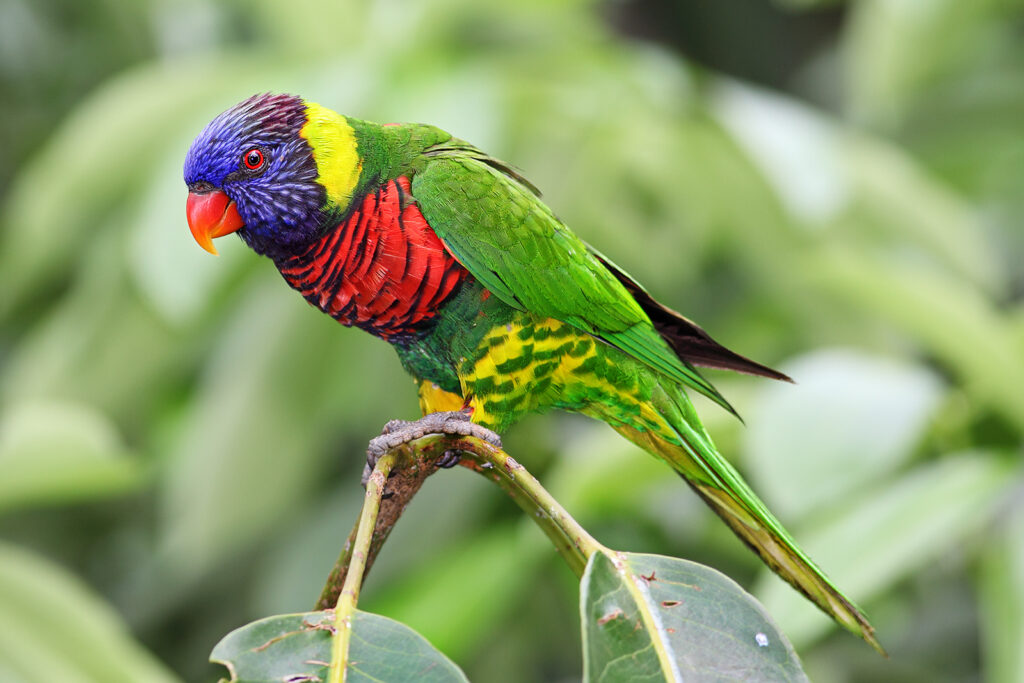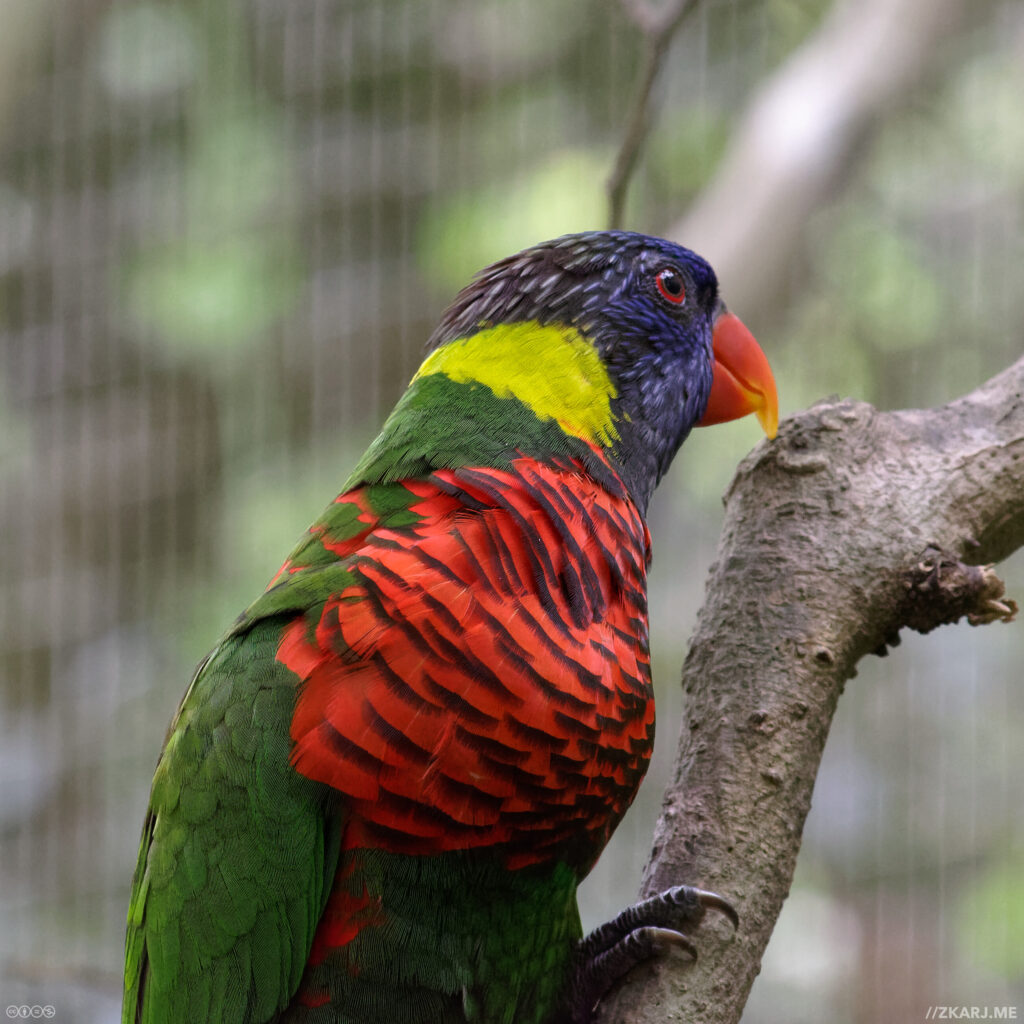Trichoglossus haematodus - Coconut Lorikeet
Photo: Benjamint444 [GFDL 1.2 (http://www.gnu.org/licenses/old-licenses/fdl-1.2.html)], via Wikimedia Commons
Coconut Lorikeet – Trichoglossus haematodus (Linnaeus, 1771) – is a very colorful medium-sized parrot widespread in a large geographical range.
They are very popular as pets or in aviculture due to their bright colors. However, before buying a lorikeet please notice that their special diet may cause some mess around the cage and require frequent cleaning!
Like other lorikeets they have a special brush like tongue with small hairs that are used to harvest pollen and nectar from flowers.
Coconut Lorikeet are monogamous and forms a tight bond with their mate – typical a lifelong bond.
Lifespan: 15-25 years
Description
The head is black with blue and light blue streaks. The nape has a yellow band; lower part of nape is green. The back and upper side of wings are bright green; wide yellow band under the wing; orange underwing coverts. The chest is red with black edges on the feathers. The abdomen is dark green. Yellow spotted with green thighs to undertail coverts. Green tail. The beak and eyes are dark orange-red.
Males and females look similar. Juveniles has a dark beak and brown eyes.
Size: about 26 cm
Weight: 100-157 g
The Coconut Lorikeet can be confused with the Rainbow Lorikeet but it is distinguished by the yellow band on the neck, red chest instead of orange and dark green abdomen instead of blue. Previously they were both classified as Trichoglossus haematodus subspecies but have been split (see below) and the Rainbow Lorikeet is now classified as Trichoglossus moluccanus.
Subspecies
Eight subspecies are currently recognized:
- Trichoglossus haematodus haematodus (Linnaeus, 1771) : Nominate form, see description above.
- Trichoglossus haematodus caeruleiceps (D’Albertis & Salvadori, 1879)
- Trichoglossus haematodus deplanchii (Verreaux, J & des Murs, 1860) : Similar to massena but with more blue streaking on head; less brown wash on occiput and nape; less yellow on thighs to undertail coverts.
- Trichoglossus haematodus flavicans (Cabanis & Reichenow, 1876) : Black head with grey/green streaking; blue/purple steaked forehead, lores and area around eyes; yellow collar; red/brown occiput; Dull green upperparts and undertail coverts; the chest is bright red with minimal barring.
- Trichoglossus haematodus massena (Bonaparte, 1854) : The body colour is paler than haematodus; the collar is more green/less yellowish; brown wash on occiput and nape; paler red breast with fine bars of blueish black.
- Trichoglossus haematodus micropteryx (Stresemann, 1922) :
- Trichoglossus haematodus nesophilus (Neumann, 1929) : Similar to flavicans but with green upper body, undertail coverts and tail.
- Trichoglossus haematodus nigrogularis (Gray, GR, 1858) : Darker blue streaks on entire crown and sides of head; orange/red breast with thin barring of blueish black.
Reclassified Subspecies
Previously the Trichoglossus haematodus species included a large number of subspecies but many of these have been reclassified:
- T. h. brooki now included in Trichoglossus haematodus nigrogularis
- T. h. caeruleiceps was previously included in Trichoglossus haematodus nigrogularis but has been split to T. h. caeruleiceps
- T. h. capistratus was upgraded to the new species: Trichoglossus capistratus – Marigold Lorikeet
- T. h. djampeanus was moved to Trichoglossus forsteni djampeanus
- T. h. flavotectus was moved to Trichoglossus capistratus flavotectus
- T. h. forsteni was upgraded to the new species: Trichoglossus forsteni – Sunset Lorikeet
- T. h. fortis was moved to Trichoglossus capistratus fortis
- T. h. intermedius now included in Trichoglossus haematodus haematodus
- T. h. micropteryx was previously included in Trichoglossus haematodus massena but has now been split to T. h. micropteryx
- T. h. mitchellii was moved to Trichoglossus forsteni mitchellii
- T. h. moluccanus was upgraded to the new species: Trichoglossus moluccanus – Rainbow Lorikeet
- T. h. rosenbergii was upgraded to the new species: Trichoglossus rosenbergii – Biak Lorikeet
- T. h. rubritorquis was upgraded to the new species: Trichoglossus rubritorquis – Red-collared Lorikeet
- T. h. stresemanni was moved to Trichoglossus forsteni stresemanni
- T. h. weberi was upgraded to the new species: Trichoglossus weberi – Leaf Lorikeet
Habitat
The Coconut Lorikeet is native to Indonesia, New Caledonia, Papua New Guinea, Solomon Islands and Vanuatu but has also been introduced to Hong Kong and Singapore.
- Trichoglossus haematodus haematodus : Southern Moluccas, western Papuan islands, western and north central New Guinea.
- Trichoglossus haematodus caeruleiceps : south-central New Guinea
- Trichoglossus haematodus deplanchii : New Caledonia including Loyalty Island.
- Trichoglossus haematodus flavicans : New Hanover and the Admiralty Island.
- Trichoglossus haematodus massena : Karkar Island, Bismarck Arch., Solomon Island and Vanuatu.
- Trichoglossus haematodus micropteryx : north-eastern and south-eastern New Guinea
- Trichoglossus haematodus nesophilus : Ninigo and Hermit Island (Admiralty Island).
- Trichoglossus haematodus nigrogularis : Kai Island, Aru Island and southern New Guinea.
Diet
The diet consist of fruit and nectar; the lorikeets use their special brush like tongue to drink nectar from flowers.
Coconut Lorikeet are nomadic as they depend on flowering trees and shrubs.
Provide some nectar (either commercial or home made) as the main part of the daily diet; also give plenty of fruit and vegetables and add some spray millet and sprouted seeds.
Aviculture
The nest box should be about 50 x 35 cm
The clutch usually has 2-3 eggs that are incubated by the hen for about 23-25 days. Fledging age is 8-9 weeks.
Taxonomy
- Order: Psittaciformes
- Family: Psittaculidae
- Genus: Trichoglossus
Synonyms
- Danish: Bjerglori
- English: Coconut Lorikeet
- French: Loriquet à tête bleue
- German: Allfarblori
- Portuguese: Lóris-arco-íris
- Spanish: Lori Arcoiris, Lori de cocotero, Tricogloso de Pecho Rojo
- Scientific: Trichoglossus haematodus
IUCN Red List

BirdLife International 2018. Trichoglossus haematodus. The IUCN Red List of Threatened Species 2018: e.T22725310A132177469.
https://dx.doi.org/10.2305/IUCN.UK.2018-2.RLTS.T22725310A132177469.en
Downloaded on 9 July 2021
Photo: David Marquina Reyes
License: Creative Commons CC BY-NC-ND 2.0
Photo: zkarj
License: Creative Commons CC BY-NC-ND 2.0
Photo: Cacophony
License: Creative Commons CC BY-SA 3.0



